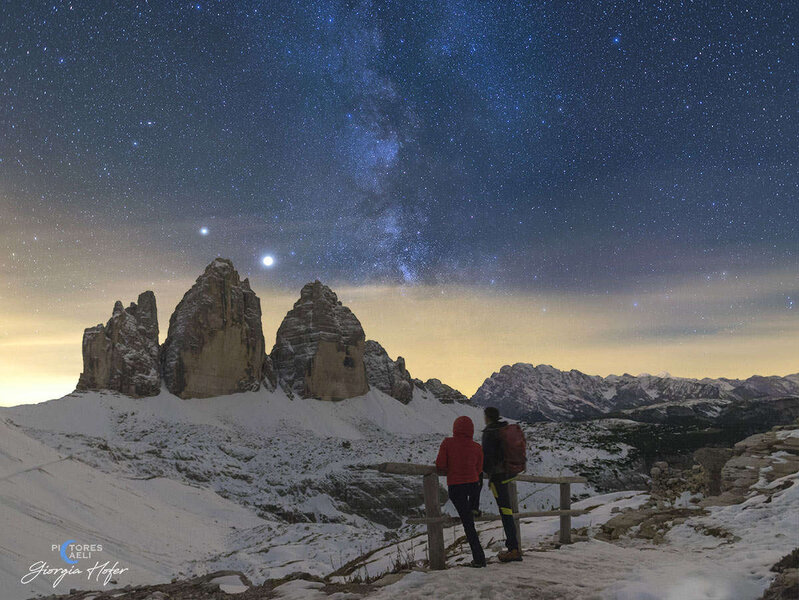Create a free profile to get unlimited access to exclusive videos, sweepstakes, and more!
Jupiter and Saturn align in the sky, their closest approach to each other in 400 years

Jupiter and Saturn are heading for quite the lover's embrace in a couple of weeks: On Dec. 21 they'll pass so close together that by eye they'll barely be distinguishable as two objects! They haven't been this close together in nearly 400 years, and won't be again for a long, long time, so catch it while you can.
If you've had a clear view to the southwest for the past few weeks you may have noticed them, two "stars," one much brighter than the other, approaching each other night after night just after sunset.
Those, of course, aren't stars. They're the planets Jupiter and Saturn. Their motion in the sky is a reflection of their own orbits around the Sun together with the Earth's changing position as we orbit the Sun. It's like watching two cars driving down the highway together from your own car. What you see depends on the motion of all three.
This kind of event, when two objects in the sky get close together, is technically called an appulse, though more commonly referred to as a conjunction. A pass this close between two planets is exceptionally rare. At their closest approach, Jupiter and Saturn will be an incredible 6 arcminutes apart: That's 1/10th of a degree, or 1/5th the apparent width of the Moon in the sky. The smallest separation the human eye can see on its own is only 1 arcminute, so they'll be close, barely distinguishable as two objects by eye. And, since Jupiter will be about 10 times brighter than Saturn, it may really look like they become one "star" in the sky.
And you don't really need any special equipment to see this (though it'll help, as I'll get to in a sec). Starting as soon as you can (tonight!) go outside after sunset as the sky starts to get dark, and look low to the southwest. Jupiter should be easy to spot, since it's quite bright, brighter than any stars around it. Saturn is above it and to the left (for northern hemisphere viewers). The two planets are already only about 1.5° apart, less than the width of my pinky held at arm's length (your pinky width may vary), and they'll get closer every night. I suggest you go out now and watch them as many nights as you can; it'll give you a lovely thrill of anticipation as they get nearer and nearer to each other (BBC's Sky at Night magazine has a great graphic demonstrating this).
But more importantly it'll give you practice finding them in the sky. By the time they're at their closest they'll only be about 30° from the Sun, which means they sink fast after sunset. The more you go out to see them before the conjunction the more prepared you'll be to find them when the time is right.
EarthSky has a lot of photos of the two leading up to the big day.
Binoculars are a great way to view the planets. If you can hold them steady enough (propping them on something helps) you should be able to see at least a couple of Jupiter's moons hugging it tightly, and possibly even Saturn's rings, or at least see that Saturn doesn't look round but elliptical.
Through a telescope the view will be incredible. Jupiter will be a disk with stripes across it — the famous storm bands you see in high-res pictures of it — and the four big moons (Callisto, Europa, Ganymede, and Io) lined up near it. Saturn will show its rings, and you may see a few moons, including bright Titan on the opposite side of Saturn from Jupiter.
If you know what you're doing — seriously, only if you've had experience doing this before — and you have a telescope, it may be worth trying to find them during the day, maybe in the afternoon when the Sun is already low. Jupiter is pretty bright and viewable in broad daylight, and if you have a modern telescope that can find objects on its own you can program it to find Jupiter. Hint: You might have to set up the night before to get everything aligned with the stars.
The last time Jupiter and Saturn were this close was in July 1623, when they passed only about 4 arcminutes apart. They were pretty close to the Sun in the sky then, closer than this conjunction in 2020, so it's unlikely they were observed (mind you, Galileo had only started using his own telescope to look at the sky a few years before that; the EarthSky website notes that the last observable close approach they had before that was in 1226). The next close pass (again, about 6 arcminutes) won't be until March 2080... assuming you expect to see that one.
There will be a handful of decent conjunctions in the coming year of 2021. In-The-Sky has a list and details (and you can set your location, so it will tell you if they're visible from where you are, too). The next good one for me will be when Venus and Mars get to about a half degree apart in July 2021, but there are plenty of others. This 2021 astronomical calendar lists a bunch of times the Moon passes planets, too, which is always fun to see.
And remember: If you can, take a chance to go outside and look up any old time. Even if it's just you under the stars, that's pretty nice, too.































